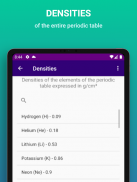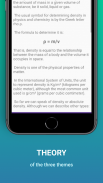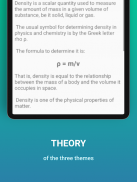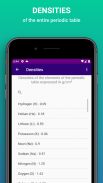














Density Mass Volume

Beschrijving van Density Mass Volume
Easily calculate density, mass and volume formulas.
You can convert the values into many commonly used units.
Theoretical topics:
Density:
Density is a scalar quantity used to measure the amount of mass in a certain volume of substance, be it solid, liquid or gas.
Relative density
Average and point density
Apparent density
Mass:
Mass is a physical quantity with which we measure the amount of matter that a body contains.
Inertial mass
Atomic mass
Molecular mass
Molar mass
Volume:
The space occupied by a body is called volume. It is a scalar metric quantity comprised of three dimensions: width, length, height.
Specific volume
You can also know the density of all the elements of the periodic table, ordered from least to greatest and expressed in g / cm³.
Hydrogen, helium, lithium, potassium, neon, sodium, nitrogen, oxygen, calcium, rubidium, fluorine, magnesium, argon, phosphorus, beryllium, cesium, sulfur, carbon, silicon, boron, strontium, aluminum, scandium, bromine, chlorine, barium, krypton, yttrium, titanium, selenium, iodine, europium, germanium, radium, arsenic, xenon, gallium, vanadium, lanthanum, tellurium, zirconium, antimony, cerium, praseodymium, ytterbium, neodymium, zinc, chromium, promecium, indium, tin, manganese, samarium, iron, gadolinium, terbium, dysprosium, niobium, cadmium, holmium, cobalt, nickel, copper, erbium, polonium, thulium, radon, bismuth, lutetium, actinium, molybdenum, silver, lead, technesium, thorium, thallium, palladium, ruthenium, rhodium, hafnium, curium, mercury, americium, berkelium, californium, protactinium, tantalum, uranium, gold, tungsten, plutonium, neptunium, rhenium, platinum, iridium, osmium.
It also contains a list of common composite densities. This list will be completed with subsequent updates.
We suggest you visit the complementary apps that will help you learn these three topics even more.
Supports Spanish, English and Portuguese language.


























